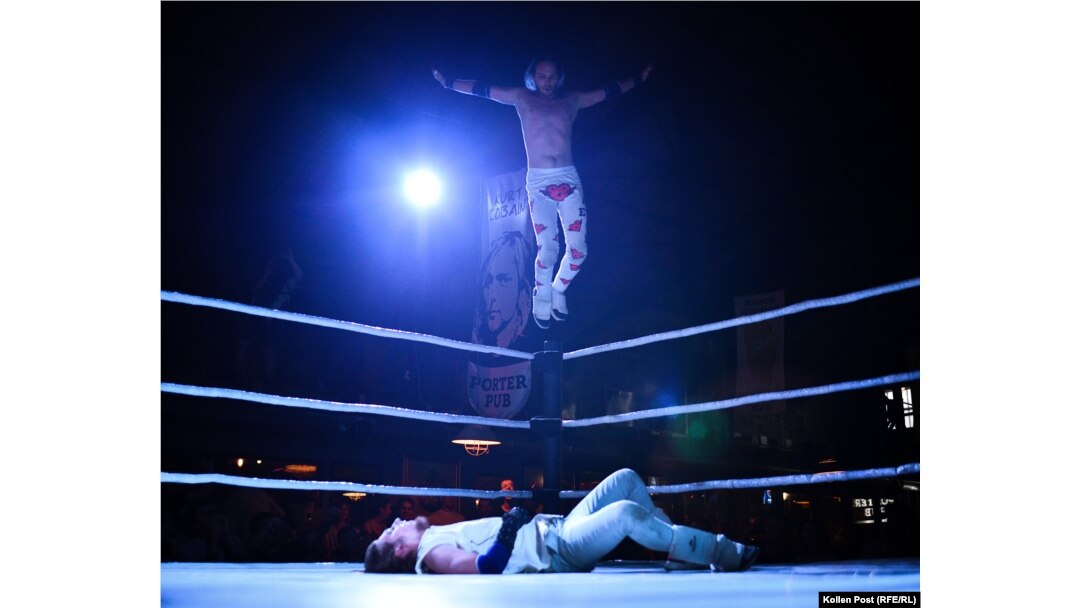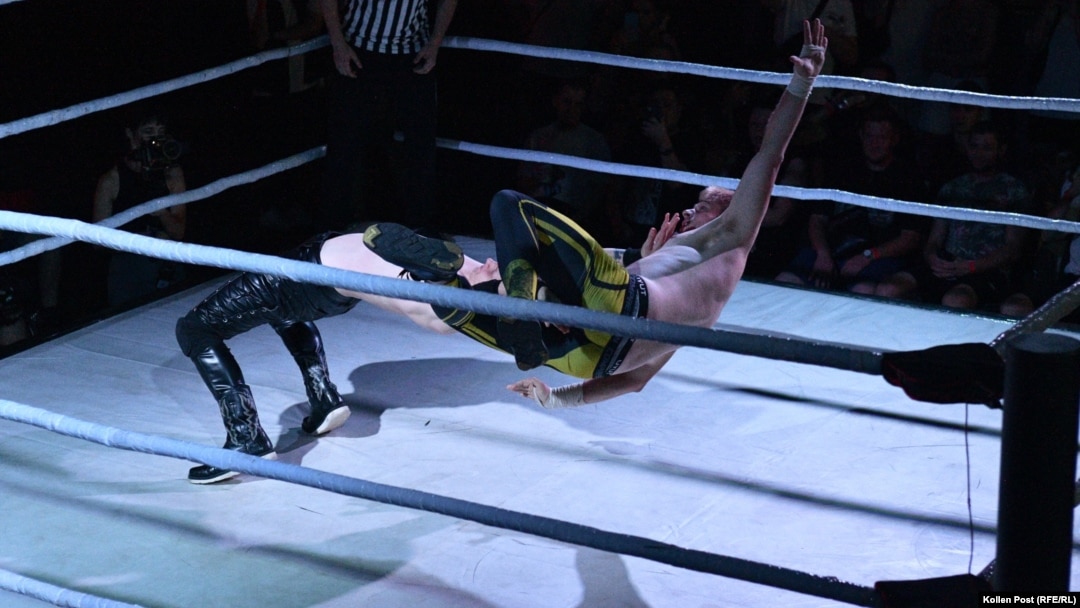KYIV -- At the climax of the show, during the last of the seven matches on the night’s bill, Hantry climbs up on the corner ropes. His opponent, Skella, is sprawled on the mat, in black-and-white face paint like a skull. Hantry pulls his signature move, the Jesus Christ drop: He jumps off the ropes, pulls a crucifixion pose silhouetted by stage lights, and then plows his elbow into Strella's back.
Two hours before the matches started, Hantry couldn’t sit still -- he kept getting up and pacing in anticipation. Hantry and other fighters practiced moves, put on makeup, and pounded beers in the dark. The power was out at the combination bar and concert venue, a reminder of the war: Russian attacks have devastated Ukraine’s electricity infrastructure, necessitating rolling blackouts in Kyiv and across the country.

A competitor who goes by the name Hantry jumps off the ropes as his rival lies prone on the mat in Kyiv.
But while power cuts and drone attacks bring the war to Kyiv daily, the fighting on stage is something else entirely. Modeled after the World Wrestling Entertainment (WWE) phenomenon, it’s an escape from the war, and part of the life that goes on across Ukraine amid – and despite – the full-scale Russian invasion, now headed toward its fourth year.
SEE ALSO: Tense Times For Ukraine As Pressure Mounts On The Battlefield And BeyondThough the sport is generally called “pro wrestling,” members of Ukrainian Wrestling Arena (UWA), performing this night before a crowd of about 200, do not get paid. By day, Hantry is Pavlo Khimonidi, a stocker in a warehouse for cosmetics.
By night, he’s a bad guy – a heel, in the parlance of the genre. He used to be a face, a good guy, but that changed earlier this year with a low blow to his longtime foe, a Ukrainian fellow UWA regular who goes by the name Kenny Rivera. After the clock ran out, he returned to the stage, slammed Rivera’s head between two chairs before forcibly taking the mic from the MC and berating the audience until they booed him offstage.
Is it more fun to be a good guy or bad guy?
"Bad, absolutely" he says. “I love it so much.”
When Hantry comes out ahead of Strella, he puts his prize belt over his shoulder, dons violet-tinted aviators, and again badmouths the crowd until they throw chairs at him, filling the stage. He then returns to the darkened upstairs corner of the hall, where the wrestlers recap the night in a wood-paneled dressing room with a conspicuous lack of ventilation.
Holding a microphone and his championship belt, Hantry berates the audience at a wrestling event in Kyiv.
Among them is Volodymyr Kefir, a former Ukrainian Wrestling Arena producer, who is originally from Dnipro and identifies as nonbinary.
Now 25, Kefir remembers the beginning of broadcasts of the U.S.-based WWE, featuring original Ukrainian commentators, in 2013. They were particularly fond of The Miz, a heel who beat John Cena for the championship belt in 2011.
'It's The Best Feeling'
Those early broadcasts were a unifying moment for the Ukrainian wrestlers of today. The first events, Volodymyr recalls, came out of a core of fans who met in 2018 at FanExpo Odesa, a fan culture event along the lines of ComicCon that has been canceled since the full-scale invasion. The venue in Odesa was destroyed in a Russian attack in September 2023.
“I am a nerd, I am a geek,” Kefir says, pulling out a chain around their neck to show the ring hanging from it. “I’ve been wearing this ring from Lord of the Rings for eight years and never take it off.”
In its early days, Ukrainian Wrestling Arena matches drew crowds of maybe 20 people, says Kefir. COVID-19 killed the budding scene in Odesa, but the performers regrouped, though they found building an audience took time.
A fan wears a mask outside a pro-wrestling event in Kyiv.
“It’s weird for everyone. People are not used to seeing indie wrestling,” says Kefir. “We’ve gotten a lot of hate on social media, because it’s not real punches, you know. But gravity still hits.”
The crew make no apologies for their love of the theater in the sport. The plotlines are set out in advance -- often through Instagram videos in which wrestlers antagonize each other in colorful ways. But there is, they insist, still a high degree of both athleticism and spontaneity to the spectacles.
"I hate scripted matches," Hantry aka Khimonidi says. "I like fear more, and feeling alive inside the ring. Because when there’s a script you always need to keep it in your head, you’re thinking ‘oh, what are we supposed to do next?’ But when it's not scripted, when you can improvise, the matches look more alive."
The performances can be as colorful as they are dramatic. Toxic Nick, a longstanding member of Ukrainian Wrestling Arena, wears a gas mask and hazmat equipment; at matches in June he smashed fluorescent lightbulbs over his opponent at the June matches, filling the stage with glass.
In the dressing room, surrounded by competitors, Skella stares down the camera.
Ukrainian Wrestling Arena relocated to Kyiv last December and has been drawing its biggest audiences ever.
“It’s the best feeling,” says Ihor, a spectator whose voice is completely shredded by the time intermission comes around. “I used to watch WWE growing up. When I found out that there was a Ukrainian variant, for me it was like, ‘Finally!’”
“This is awesome, bro,” says Andriy, visiting Kyiv from the western city of Rivne along with three friends.
“It’s our first time at something like this. The girls were into the cowboy,” he says, referring to Dmytro "Gambit" Shamray, who took to the stage in a black cowboy hat and bandanna.
'More Entertaining Violence'
Most of the spectators were watching Ukrainian Wrestling Arena for the first time. Many of the performers were novices, too: Twelve had made their debut since December, and three had not been in the ring before.
Kefir says you can often tell when a wrestler started by the names they use, which reflect an increase in pride and a strengthening national identity since the start of Russia’s full-scale invasion.
Yaros Lyutiy's name appears onscreen at a pro wrestling event in Kyiv.
“Before the war their names would have been anglicized -- Hantry, Russell Cross, Toxic Nick. But the new guys — Lyubomyr, Yaros Lyutiy — these are Ukrainian names. We have this new guy named Kosherniy, like a chef.”
Several of their longtime colleagues have gone to active duty at the front – wrestlers who performed under the names of Ranger Leonid, Codename Toni, and Andrew Reed. The first two still show up for fights but “Andrew Reed is a guy we haven’t seen for a while now,” says Hantry.
When asked about joining the army himself, he says he’d thought about it but had been strongly discouraged by friends who are already in.
Hantry envisions taking the shows to the troops near the front.
“They hate violence, true,” he said. “But if they see that type of violence, it’s like more entertaining violence, where anyone can choose whom to cheer and whom to dislike, and also they can have a good time, and their minds can rest from the war and just have fun.”


